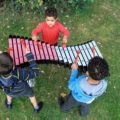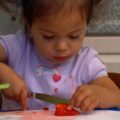How making a Wormery supports your child’s early years education
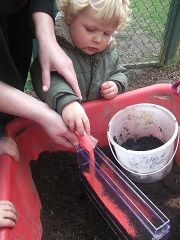
Equipment needed:
- Commercial wormery kit or narrow clear plastic tank or container with lid
- Cardboard sleeve to wrap around the container, making it dark for the worms. This can be decorated.
- Different coloured soils, compost and sand to layer in the container, kept slightly damp and topped with leaf litter
- About 5 big earthworms!
Children can take part in every step of this hands-on activity both as individuals and as a group, developing their social interaction skills.
At Hale Day Nursery, we looked at how this activity enhanced learning opportunities for the children aged 2-3 who took part across the 3 main ‘prime’ and 4 ‘specific’ areas of the Early Years Foundation Stage – if your child is older there will be different early learning aspects to consider:
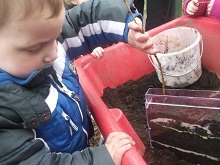
Personal, Social and Emotional Development (Prime area)
In this important area of learning, one aspect is guiding children in making relationships and showing care and concern for others. As a group the children hunt for the worms. We explain that we can look in any area of undisturbed earth, under rocks and logs. Children cooperate and work together with the adult and friends as they take turns to lift objects. When a worm is found, it’s important to explain how to be gentle when moving the worm to the wormery, so we don’t hurt the worm.
Physical Development (Prime Area)
This is a perfect activity to get to grips with several aspects of this crucial area of learning. It’s easy to discuss the importance of health and self care as we dress up warmly to go outdoors. And after digging in the garden and getting muddy, explaining why not to put dirty fingers in mouths – and that we should wash our hands – a great way to understand the importance of personal hygiene.
Hunting the worms is a great physical work out: bending, lifting, stretching but also small motor movement: carefully pouring soil into a narrow container, carefully lifting and balancing a worm on a stick whilst transferring it into the container.
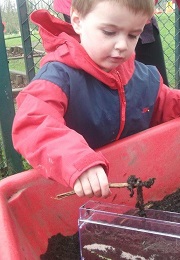
Communication & Language Development (Prime Area)
Children’s speaking skills grow as new words are learnt: mathematical language as well as words such as soil, sand, compost, layers, worms, wormery, digging, the different colours of the sand and soil layers. Their listening skills are challenged as children are given instructions, as well as their understanding skills – as they are guided into getting the instructions right.
Knowledge & Understanding of the World (Specific Area)
One of the topics to explore is ‘looking at our environment in detail’: building a wormery is perfect for this. As the worms settle in and start making their tunnels, we can explain to the children that this is what happens all the time in the ground under our feet, we just can’t see it. We can explain how the tunnelling helps to mix up the soil and leaf litter and lets air and water into the soil, making it better for plants to grow. Healthy plants (like vegetables) means healthy animals who eat the plants, including us!
Maths (Specific Area)
Children can engage in discussing the shape of the container, using mathematical language such as ‘narrow’. The sand and soil can be measured in using ‘half’ a cup or a ‘full’ cup. We begin to use the language of size: small, big, thin, fat, short, long, layers. Numbers are introduced as we count 5 worms, or extended as we count the number of layers. Children can recite the numbers with you.
Expressive Arts & Design (Specific Area)
An aspect to cover in this area is exploring and using media and materials – various construction materials are used, with different properties: the container and cardboard sleeve, the soil, sand and compost and the leaf litter.
Building the wormery develops control holding skills and decorating the outer cardboard sleeves allows children to using mark making materials.
Literacy (Specific Area)
Children’s reading and writing skills can be enhanced through storytelling so they can learn to enjoy books. Looking at the shapes of the tunnels allows the youngest children to observe trails, like mark making. Older children may be able to recreate the patterns.


